To get out of my dark mood of semi-hibernation I tried to motivate myself to go to the gym. In the end my trainers did not leave my bedroom nearly as often as I had hoped but whenever I went I always felt energised. It was great to listen to cheesy music at full volume and run at full pelt. Going with a friend also made it a social occasion. But the workouts could be quite tough as I was still saturating only 90% oxygen in the thin air.
[pullquote] We could walk out the door just after lunch, look up and see the Milky Way hovering above us.[/pullquote]
Without doubt my favourite thing about the winter stay was seeing the night sky. It was almost invariably crystal clear. I could not believe there could be so many stars in a sky – they were so crowded together it looked like they were fighting for space. The experience was made still more unusual as this spectacle was visible all around the clock. We could walk out the door just after lunch, look up and see the Milky Way hovering above us.
Concordia is a very attractive place for observing the Universe. This is thanks to the thin and dry air, clear skies and absence of pollution, including light pollution. The possibility of non-stop, round-the-clock observations during the long Antarctic winter has attracted many astronomers and today a number of telescopes are installed around the station.
Looking up towards such a plethora of stars – many of them with planets of their own we know today – I could not help wondering what worlds might be out there, and whether there could be anyone or anything lookinga back in our direction. It felt strange and exciting to run experiments preparing for humans to stay on moons and planets, with the Milky Way in all its vastness and splendour right above our heads. Would humankind one day even take that real step to the stars and travel beyond our Solar System?
There were also many shooting stars visible. These are meteorites flaring up as they descend through the Earth’s atmosphere at high speed. Antarctica is sometimes called a “meteorite trap”. This is because although meteorites come down randomly all across Earth, Antarctica is the premier location for finding them. They are spotted much more easily against the backdrop of the ice than against vegetation or stony ground, not to mention under the sea. Natural changes in the ice sheet also lead to ancient meteorites being exposed by melting, and there are many places in the ice where any rock exposed must have fallen from above. These rocks from other planets, moons and asteroids help scientists build up the picture of how the Solar System formed and developed. Teams from Europe, Japan and the United States make regular trips to Antarctica to systematically search for meteorites. More than 50,000 have been recovered by different international research teams. Perhaps the most famous is Allan Hills 84001, from Mars, that fuelled a worldwide debate about the possibility of life on the Red Planet.
An even more spectacular phenomenon was the aurora, the southern lights. I will never forget the first time I saw them. I was woken up in a hurry by one of the crew members shouting I had to get up and see this. In my excitement I quickly wiggled into a pair of skinny jeans and a t-shirt and just threw my polar suit over that. We rushed outside and it took a few seconds for my eyes to get used to the dark. Above us hovered what looked like a small cloud. But it was glowing and changing before our eyes, radiating in green and blue and yellow. It was almost as though you could reach out and touch it. This was a fleeting occurrence though and it soon faded away. That might have been as well, for this time, as I had already got very cold. I actually had to rush inside so as not to risk frostbite. This taught me that no aurora is worth compromising your personal safety for in the temperatures we had.
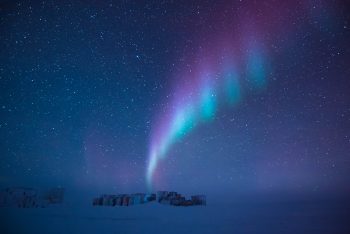
Auroras occur frequently over both the North and South polar regions. Credits: ESA/IPEV/PNRA–B. Healey
[pullquote] I had to rush inside so as not to risk frostbite.[/pullquote]
Auroras occur frequently over both the North and South polar regions. They occur when charged particles from the Sun hit Earth’s atmosphere. This is one feature of what is called “space weather”. The very southern location of Antarctica means that the Earth’s magnetic field passes at near vertical there. It makes Antarctica an ideal place for studying the magnetic field and space weather phenomena. This is done not only to improve our abstract knowledge. Space weather can directly influence space-based telecommunications, broadcasting, meteorological observations, satellite navigation and even Earth-based communications, electricity grids, railway networks and gas pipes.
We enjoyed many more auroras over the course of the long polar night. Sometimes they would light up the horizon like a sunrise, which was tantalising for us who lived without sun for so long. Other times they would float above us, stretching out across the sky in ethereal curtains of glowing colours. I really enjoyed these opportunities to practise my photography.
We did not see the sun for 105 days at Concordia during this polar night. Much like me, I am sure everyone was affected, but the crew reacted in different ways and people were affected more at different times. It was difficult to predict how people would feel and behave on different days.
[pullquote]There was soon a clear divide with one group waking up early and one instead being active very late.[/pullquote]
The interaction of the crew changed over the course of the winter with some consistencies. What happened was that the crew divided into sub-groups, basically along the lines of professional roles and nationality. Each group slipped into different group patterns of sleep and leisure activities. There was soon a clear divide with one group waking up early and one instead being active very late. This at times caused tensions. It will be interesting to see the detailed results of the data collected by the activity watches on this.
It was useful to take time for yourself, to learn how to develop a thick skin and not always take things people say to heart. You had to keep in mind that people could be having tough days for reasons completely unrelated to you. Keeping the crew members participating in the experiments was a constant challenge that I focussed on regardless of the mood.
Without doubt the Human Behaviour and Performance training that we had received at the European Astronaut Centre was really useful for our stay. It gave us an understanding of our personalities and what reactions we could expect when people were finding things tough. It also provided us with a better cultural understanding.
There is a traditional celebration in Antarctica called Midwinter. It takes place during the middle of the polar night and is celebrated by all stations. At the start of Midwinter we received greetings from all of the crews around Antarctica. It was lovely to feel part of this wider community and it made me feel less isolated. During our own celebrations we organised a number of social events, including a performance of our own crew band. We also Skyped France’s Dumont d’Urville station to wish them a good time. Celebrations like these were not just for fun; they were very important to break the monotony we all had to deal with. But sometimes it was not so easy to organise a social event around, say, a crew member’s birthday, because it required a two-way effort. Often people would not appreciate the efforts made and leave early or not come at all.
[pullquote] I did not see greenery, mud, brick buildings, animals, children or elderly people for a full year.[/pullquote]
Staying on the same spot, in the same building, for over a year really did get to me. I did not see open water during the whole stay. I did not see greenery, mud, brick buildings, animals, children or elderly people for a full year. There was also sensory deprivation in terms of colours and smells. It is funny what you miss – for me the smell of plants or freshly cut grass just after the rain. Many of these things completely left my mind. Sometimes when watching a DVD movie I would be jolted, being suddenly reminded of things no longer part of my world.
The pressure we felt became more and more evident. People started making verbal attacks on each other. Also small things can have a real effect on you when you are tired and have been in isolation for too long. Verbal attacks were both of a professional and a personal nature.
Jealousy was also an issue. Receiving a simple gift from a crew member resulted in complaints about my work, despite it being performed in exactly the same manner throughout the winter. There was also hostility towards people who were more friendly with another group than usual.
In my case, maybe in part because I am a younger girl, any sign of friendliness towards me was often seen by others as being about more than friendship. This made it difficult for people to be friendly without a risk of being accused. People who chose to be friends with me may have found themselves rejected by others.
The verbal attacks and the jealousy are not just personal details of my stay. It has to be remembered that as participants in the ESA-sponsored experiments we were contributing to the preparation of human spaceflight missions. For these, also the very human and emotional reactions coming from isolating any crew will have to be taken into account. Whether a behaviour is professional or not, reasonable or stemming from stress or mood swings, it counts.
[pullquote] It could be quite a challenge to go outside at -80C to retrieve a casualty.[/pullquote]
Fortunately we did not have any real medical emergencies during the winter. We did complete fire and medical training exercises on a regular basis where we had to react under stress and challenging conditions. As the ESA medical doctor of the station, I led the medical rescue team and it could be quite a challenge to go outside at -80C to retrieve a casualty. Things that you do not expect can take you by surprise, such as when the straps of our stretcher instantly cracked due to the cold. In addition, wearing all the polar gear made movement and communication with the team difficult. It was therefore difficult to react to dynamic and evolving situations as you have to in medical emergencies. During episodes of high stress I would often find that people reverted to their native language. This would make communication difficult when it was needed the most – and would be potentially dangerous if a serious problem was to occur. This is also a relevant consideration for spaceflight. Such a situation should be avoided where possible.
Being away from friends and family was without doubt one of the toughest parts of this experience. At difficult times there is nothing quite like calling up one of your best friends. At Concordia we were limited in our telecom means, but most of the time we did have both telephone (by satellite) and internet access. Speaking to the outside world helped put things into perspective.
That said, I was not in touch with the outside world as much as I had expected. I ended up having just a few people that I contacted on a regular basis, rather than more people less frequently. I found that being in touch too often made the isolation experience more difficult. I became aware of what I was “missing out on”, including a friend’s engagement and an entire pregnancy and birth within the family. And I quickly felt disconnected from the crew if I spent too much time making calls. I think the key is to create a good balance – not cutting yourself off from home but still taking the time to integrate with the crew and the reality of your surroundings. There was always a concern at the back of my mind that everyone outside would move on without me, almost as though I would lose my place in the world.
[pullquote] But support also came from elsewhere – even from space![/pullquote]
But support also came from elsewhere – even from space! ESA astronauts Samantha Cristoforetti and Tim Peake both kindly sent me messages over Twitter wishing our crew good luck or passing on words of encouragement. Samantha also called our crew live from space during our darkest period. She was really friendly and gave us a full virtual tour of the Space Station, including a look back at the Earth from its Cupola window.
Others with experience of isolation, like Romain Charles and Diego Urbina from the Mars500 study also offered support and advice. This was particularly useful as the Mars500 team had very similar experiences of isolation.
This all helped me maintain my motivation during the winter. I felt as though I had joined a large family of people who had gone through similar experiences. I was suddenly able to relate closely to those and other people working in similar environments.
But at some points I felt like the winter would never end. Each day merged into the next and it was hard to remember life different to this. In the crew, tensions were high and for most people just small issues could tip them over the edge. I remember discussing in our weekly meeting for almost an hour the problem that the paper napkins may run out before the end of the winter and the anxiety this caused.
One evening, when I was feeling particularly low, I went outside together with a colleague to take some photos. I desperately needed to get out of the building to have a change of environment. As we were discussing where to go for our one chance at a quick photo session, there we saw it stand in front of us. I could not resist the calling. The “American Tower”, the scientific scaffold structure which soars 40 metres high off the station. It was sometimes necessary for a member of the scientific teams to climb up the tower to clean the instruments up there of snow. I now had the idea to take a photo of the winter night landscape from the top of the tower. My colleague questioned whether this would be such a good idea, considering the hazardous conditions outside, even on the ground. But I instantly heard myself say “Yes, I have to do it.”
[pullquote] Alone in the dark, we climbed higher and higher on the lone scaffold covered with hoar frost.[/pullquote]
Alone in the dark, we climbed higher and higher on the lone scaffold covered with hoar frost. The climb was difficult and soon turned frightening. The freezing temperature and thin air did not make the exertion any lesser, and it was difficult climbing in our layers of polar clothing. Halfway up I almost slipped and had to fight back a rising fear. I was on the verge of heading back down.
At that moment, however, a small gift I had received from the astronaut Samantha Cristoforetti, came to mind – the “Don’t panic” key ring. No, I would not panic. I would continue up. Summoning all my resolve, I forced myself to climb onwards, one step at a time. It was slow going, as you had to be very careful not to slip on the icy structure. The several layers of polar gloves isolated my hands from feeling if I had a good hold. But the words from the people back home who had supported me to come here echoed in my mind. You can do it.
Finally I made it to the top of the tower. My colleague came up right after me and gave me a polar hug. It felt like we were floating up there among the stars filling the night sky all around us. The cold was now starting to really get to us and I could hardly feel my fingers as I balanced the camera’s tripod over the scaffold at the top. With numbing hands I pushed the button and took the photo, capturing this moment of victory in one shot of winter.
Afterwards, when I looked at the picture I wondered if it had been worth such a trial for just a photo – that did not even come out as anything extraordinary. But strangely enough I felt a surge of satisfaction holding that picture in my hand. A feeling of regained confidence stayed on for that last part of winter.
That feeling was reinforced a few weeks later as I watched together with the whole crew the first rays of the sun as it barely managed to peek above the horizon.
We had made it through winter.
A new part of the story is published here about every other week...

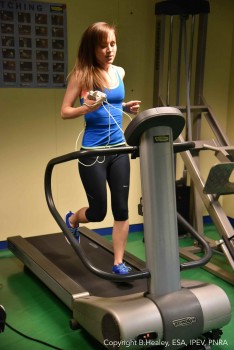
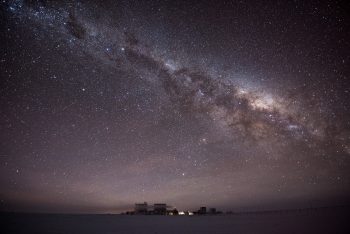
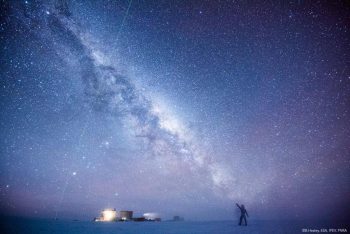
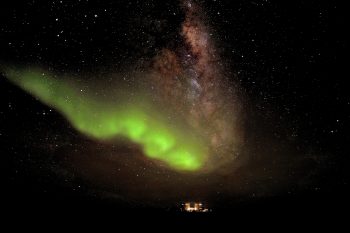
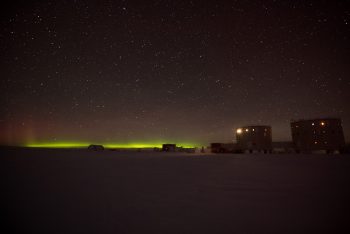
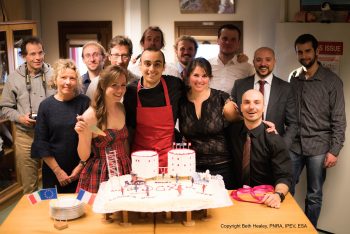
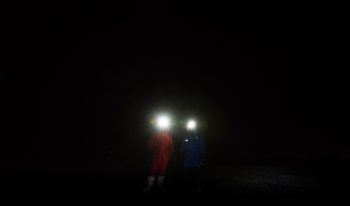
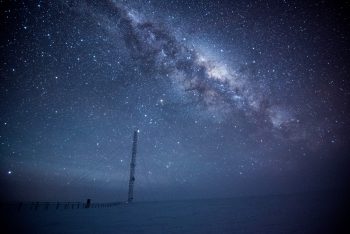
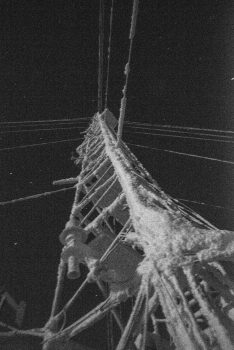
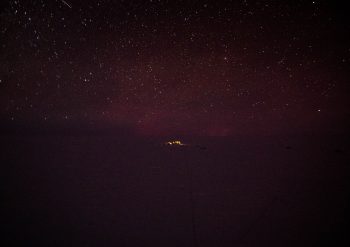



Discussion: 2 comments
Thank you. I realise it must have been hard for you to share your experience, but I feel that through you I have learned not only about life in your station but also what an extraterrestrial community would be like. I tried to imagine it in” Vagabond Two” but did not have the benefit of your account then.
Would it be worse if there was no prospect of returning to Earth – are you think about that your tour would come to an end?
I wonder if it is like living on a ship (although one that was going nowhere?) in that it has a function and sense of purpose and applied rules and discipline?
Wow! It really sounds like an experience that really digs deep into your strengths and weaknesses. I have no idea how you could climb that tower in any conditions, but pitch black Antarctic winter is pretty unbelievable. Did you have a safety harness on?
Did you drive out to the tower before you climbed it or did you walk? It looks like it’s over a mile away!
Incredible stuff!!